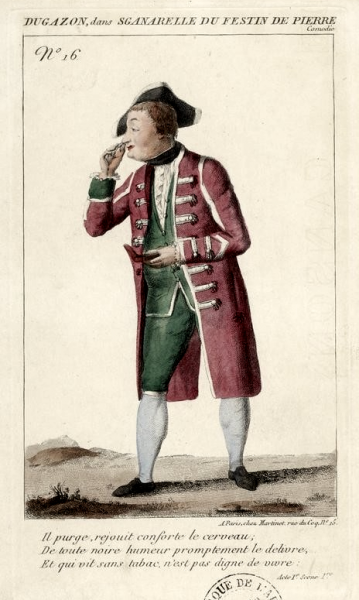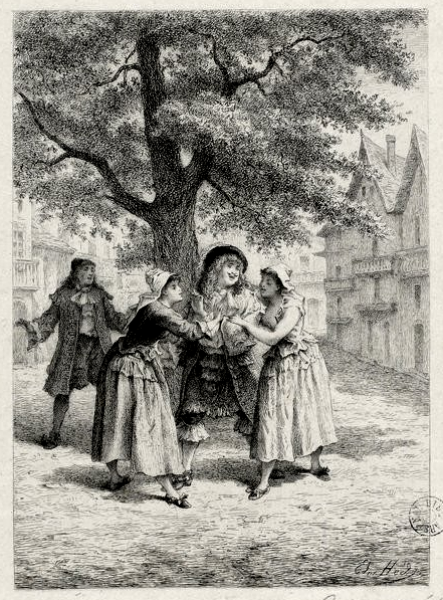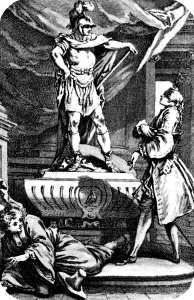Tags
Brett B. Bodemer, Dom Juan, Master & Man, Molière, Pascal, Sganarelle, Sganarelle & Dom Juan, W. G. Moore

Our dramatis personæ is:
DON JUAN, son of Don Louis
SGANARELLE, valet of Don Juan
DONNA ELVIRA, wife of Don Juan
GUSMAN, horseman (écuyer) to Elvira
DON CARLOS, brother of Elvira
DON ALONSE, brother of Elvira
CHARLOTTE, peasant-girl
MATHURINE, peasant-girl
PIERROT, peasant
THE STATUE OF THE COMMANDER
LA VIOLETTE, a lackey of Don Juan
RAGOTIN, a lackey of Don Juan
M. DIMANCHE, merchant
LA RAMÉE, swordsman (spadassin)
ENTOURAGE OF DON JUAN
ENTOURAGE OF DON CARLOS AND DON ALONSE
A GHOST
Set in Sicily
Dom Juan and Sganarelle
At the end of my first reading of Molière‘s Dom Juan (Part One), I quoted Sganarelle, Dom Juan’s valet, a role played by Molière. La Grange played the role of Dom Juan.
When Sganarelle hears Dom Juan say that he wishes his father, Dom Louis, were dead, he is indignant, but Dom Juan does not allow him to speak about “le Ciel,” heaven. Sganarelle’s living depends on Dom Juan. So, when Dom Juan dies, he thinks of his wages: Mes gages ! mes gages ! mes gages ! (My pay! My pay! My pay! ) (Sganarelle I. vi; I. 6). However, although Dom Juan will not accept remonstrances, Sganarelle manages to wrap the truth inside a lie. Such a response demonstrates ingenuity.
Will Moore writes that Dom Juan is “master” and Sganarelle, “man,” and that exchanges between master and man are:
… a dialogue on humanity. The master is inhuman in his scorn of others. The man is all too human. [1]
Man says:
Oui, Monsieur, vous avez tort d’avoir souffert ce qu’il vous a dit, et vous le deviez mettre dehors par les épaules. A-t-on jamais rien vu de plus impertinent? Un père venir faire des remontrances à son fils, et lui dire de corriger ses actions, de se ressouvenir de sa naissance, de mener une vie d’honnête homme, et cent autres sottises de pareille nature. Cela se peut-il souffrir à un homme comme vous, qui savez comme il faut vivre? J’admire votre patience, et si j’avais été en votre place, je l’aurais envoyé promener. Ô complaisance maudite,à quoi me réduis-tu ?
Sganarelle à Dom Juan (IV. v, pp. 56- 57)
[Yes, Sir, you are wrong to have suffered what he said to you and you should have thrown him out on his ear. Has anyone ever seen such impertinence? For a father to come and reproach his son, to tell him to correct his actions, to remember his birth, to lead the life of an honorable man, and a hundred others stupidities of a like nature! That it should be borne by a man like you, who knows how one must live! I marvel at your patience; and f I had been in your place, I would have sent him packing. O evil complicity! To what have you reduced me?]
Sganarelle to Dom Juan (IV. 5, p. 50)
We meet Sganarelle in Act One, Scene One. Dom Juan is out of hearing, so Sganarelle tells Guzman that his master is forever marrying. He also points to the dichotomy in Dom Juan himself. Dom Juan “un grand seigneur, méchant homme.” Act One, Scene One also allows Molière to tell about Dom Juan’s numerous marriages.
Molière’s plots are as simple as possible. When the curtain rises, Dom Juan has abandoned Done Elvire, whom he took away from a convent and we are told that six months earlier he killed the Commandeur. Molière’s Dom Juan does not contain a seduction scene nor a duel, which is consistent with bienséances (étiquette), a rule in seventeenth-century theater.
However, the play ends with the death of Dom Juan. The statue of the Commandeur comes alive at the end of Act Three. The Commandeur, is the stone guest. Dom Juan invites him to dinner the following day and, to Sganarelle’s horror, the statue comes to dinner and invites Dom Juan to dine with him the following day, which is when the Commandeur takes his hand and throws him into a fiery abyss. In Act One, Scene Two, Sganarelle asks Dom Juan whether he fears revenge on the part of the Commandeur. Dom Juan doesn’t, but Sganarelle believes friends and relatives might be angry. In Act One, Scene Three, Done Elvire visits Dom Juan. Dom Juan will not go home to his wife. She will therefore focus on revenge.
For the most part, I will skip Act Two (summary), the scene where Dom Juan nearly drowns, but is saved by Pierrot and falls in love with two peasant-girls: Charlotte and Mathurine, promising each one that he will marry her. Pierrot loves Charlotte. This scene contains a comedic element. Dom Juan runs from girl to girl whispering to each that she’s the one. At the end of Act Two, La Ramée warns that twelve horsemen are looking for Dom Juan.

Pierrot, Charlotte, Dom Juan et Mathurine par Edmond Hédouin
Master and Man
However, I would like to contrast “master” and “man,” or master’s religion and man’s religion.
In Act Three, Scene One, Dom Juan says:
Je crois que deux et deux sont quatre, Sganarelle, et que quatre et quatre sont huit.
Dom Juan à Sganarelle (III. i, p. 36)
[I believe that two and two makes four, Sganarelle, and that four and four makes eight.]
Dom Juan to Sganarelle (III. 1, p. 31)
Dom Juan is an atheist, but Sganarelle believes in God and marvels at what the human body can do:
Mon raisonnement est qu’il y a quelque chose d’admirable dans l’homme, quoi que vous puissiez dire, que tous les savants ne sauraient expliquer. Cela n’est-il pas merveilleux que me voilà ici, et que j’aie quelque chose dans la tête qui pense cent choses différentes en un moment, et fait de mon corps tout ce qu’elle veut? Je veux frapper des mains, hausser le bras, lever les yeux au ciel, baisser la tête, remuer les pieds, aller à droit, à gauche, en avant, en arrière, tourner…
Il se laisse tomber en tournant.
Sganarelle à Dom Juan (III. i, pp. 36-37)
[Well, my argument is that there is something admirable in man, no matter what you might say, which all the learned men cannot explain. Is it not a marvel that I am here, and that I have something in my head which makes me think a hundred different things at once, and that can make my body do what it would? That I can clap my hands, raise my arms, lift my eyes to Heaven, lower my head, move my feet, go to the right, go to the left, forwards, backwards, turn …
He falls while turning.
Sganarelle to Dom Juan (III. 1, p. 32)
Pascal wrote that there were two entries to the soul: the mathematical and the intuitive mind [EBook # 18269]). L’esprit de finesse does not exclude l’esprit de géométrie (mathematical). On the contrary. Sganarelle is uneducated, but it turns out that he is right and that Dom Juan is wrong. Molière is true to the legend in which a statue, the Stone Guest, kills Dom Juan. Valets are not necessarily inferior to their master. Even the humble can sense what they cannot formulate. Sganarelle runs out of words and wishes Dom Juan had stopped him.
Oh dame, interrompez-moi donc si vous voulez, je ne saurais disputer si l’on ne m’interrompt, vous vous taisez exprès, et me laissez parler par belle malice.
Sganarelle à Dom Juan (III. i, p. 36)
[Oh! Damn, interrupt me, if you please: I cannot argue with you if you don’t interrupt me: and you’re being silent as a stump out of deliberate malice.]
Sganarelle to Dom Juan (III, 1, p. 32)
In Act Three, Scene Two, Dom Juan and Sganarelle meet a beggar. The beggar gives them directions, but he is poor and needs money. Dom Juan asks him to swear. The poor man refuses the money, but Dom Juan leaves a Louis d’or behind pour l’amour de l’humanité, for the love of humanity. (III. ii. p. 32)
In Act Three, Scene Three, Dom Juan saves Dom Carlos, Done Elvire’s sister, whom he doesn’t know. In Scene Four, Done Elvire’s other brother, Dom Alonse, enters and recognizes Dom Juan. Dom Carlos succeeds in delaying the revenge. In Act One, Guzman was surprised that a man of Dom Juan’s rank would leave a wife he married despite l’obstacle sacré of a convent.
These two scenes soften Molière portrayal of Dom Juan, but in Scene Five, as our pélerins continue walking in the direction of the city, they inadvertently reach the commandeur‘s monument. Dom Juan asked Sganarelle to invite the commandeur for supper the next day. Dom Juan remains defiant. In fact, this seems bravura, but it could also be mindlessness, insouciance, or perhaps a sense that one cannot escape one’s fate. Why else would Dom Juan silence Sganarelle? He may well feel guilty, but the consequences are unavoidable, by Dom Juan’s own mathematical standards: “two and two makes four.”
Which takes us to an essay by James Doolittle on the “humanity” of Molière’s Dom Juan and a reference to Miguel de Cervantes’ Don Quixote.
We close here. There will be a third and final part.
RELATED ARTICLES
- Reading Don Juan (Part One) (6 August 2019)
- Molière page
Sources and Resources
- Pascal‘s Pensées are Gutenberg’s [eBook # 18269)
- New Criticism, definition
- Finesse et Géométrie, Encyclopédie de l’Agora
- Dom Juan is a toutmolière.net publication
- Don Juan’s translation is by Brett B. Bodemer
Molière plays featuring Sganarelle are:
Le Médecin volant (The Flying Doctor) (1659)
Sganarelle, ou le Cocu imaginaire (The Imaginary Cuckold) (1660)
L’École des maris (The School for Husbands) (1661)
Le Mariage forcé (1664)
Dom Juan (1665)
____________________
[1] W. G. Moore, Molière, a New Criticism (Oxford: Clarendon Press, 1956 [1949]), p. 96.
Love to everyone 💕
A. VIVALDI: «Filiae maestae Jerusalem» RV 638
[II.Sileant Zephyri],
Ph.Jaroussky/Ensemble Artaserse

Dom Juan (théâtre-documentions.com) BnF
© Micheline Walker
11 August 2019
WordPress


Thank you for a fascinating second part, especially the discussion regarding mater and man. Looking forward to the final part of the Dom Juan series.
Have a wonderful week, dear Micheline.
LikeLike
That part tells us so much about Molière’s Dom Juan. The play has to be read in minute details. It should also be placed within its broadest context. Authors, such as Pushkin, revealed the dichotomy. Sganarelle was not allowed to mention Heaven, but he did so. Everyone wanted to save Dom Juan. Have good day my dear.
LikeLiked by 2 people
All very true, and you are the expert, of course, but Pushkin’s play is a tragedy, in contrast to Moliere’s comedy. Everyone is trying to save Dom Juan, who obstinately refuses to be saved. In modern terms, psychology would view him as a teenager who refuses to grow up but attempts to prove himself through his conquests.
Have a wonderful day, dear Micheline.
LikeLike
That’s how it is. The good Dom Juan is rooted in Molière. He put in the nuances. Yes, Dom Juan is the teenager… When Guzman cannot understand why an aristocrat would not live up to his rank, Sganarelle says: he is “still young”. Love, Micheline
LikeLiked by 2 people
Oh yes, I do remember Sganarelle’s remark. The Russian translation makes it a noun, rather than an adjective, which is more expressive in this case.
LikeLike
At first, that comment seems inappropriate, but Molière had a reason to describe Dom Juan as “still young.” He is tolerant of Dom Juan from the beginning of the play. The play has coherence.
LikeLiked by 2 people
It certainly does, but I am wondering whether in the original the “still young” remark has the same connotations as in Russian.
LikeLike
It may not. Dom Juan is an enigmatic play.
LikeLiked by 1 person
Very true, both enigmatic and multi-faceted.
LikeLike
Molière is never easy, but he is fascinating. You are quite right, it is multi-faceted and I doubt the play will ever be understood fully. But the “master” and “man” relationship is the most important relationship in the play. Have a good day.
LikeLiked by 1 person
You too, have a wonderful day, dear Micheline.
LikeLike
🙂
LikeLiked by 1 person
So you are still having computer problems?
LikeLike
Yes Derrick, I must purchase a new one and keep delaying this purchase. The apartment still needs this and that… Imagine trying to change image and losing an entire post. Fortunately, the post is in Word. Going from a French text to an English may lead to mental fatigue. We bloggers do not have an easy life. I hope you are both well. 🙂
LikeLiked by 2 people
We are thanks X
LikeLike